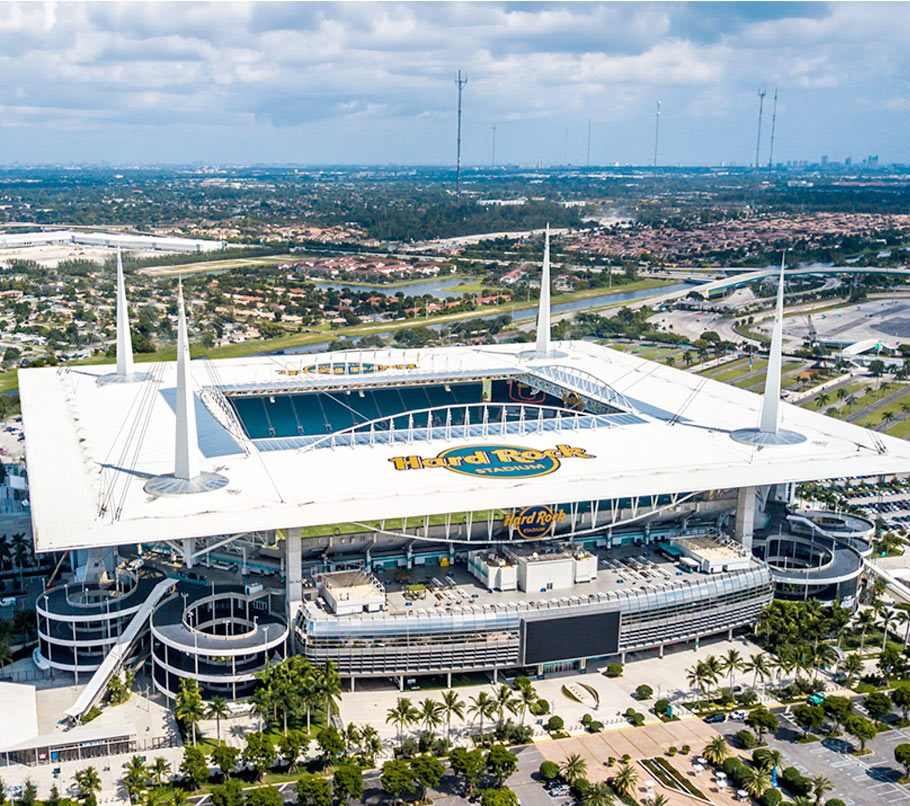Introduction
The final game of post-season football requires bleeding-edge wireless performance for tens of thousands of fans, media, and broadcasters. Hard Rock Stadium required a neutral host Distributed Antenna System (DAS) for 4G LTE with 5G mm-Wave and Wi-Fi overlays. The system needed to support more devices and increased bandwidth for enhanced digital interactions, such as an interactive augmented reality (AR) fan experience. The DAS inside Hard Rock Stadium required a power distribution system capable of safely supplying significant amounts of power across long distances to energize radio locations that were difficult to reach.
The Hard Rock DAS uses hundreds of radios. Locating radios in conveniently powered locations would require placing many more radios to meet the venue’s coverage and capacity expectations. Alternatively, provisioning dedicated AC power drops for each of these devices would be a massive undertaking, with significant budget and scheduling consequences. Download The Case Study
Project Overview
The Facility
Hard Rock Stadium is a beacon of modern sports and entertainment architecture in Miami Gardens, Florida. Home to the Miami Dolphins and a venue for major concerts, international soccer matches, and marquee events like the Super Bowl, the stadium boasts a capacity of over 65,000 seats. Its innovative design includes a canopy that covers 92% of seats, shielding fans from the elements while enhancing acoustics and providing an optimal environment for immersive experiences. With over 1.5 million square feet of space, the stadium features multiple levels of seating, luxury suites, VIP lounges, and expansive concourses, all demanding seamless wireless connectivity to cater to the diverse needs of its discerning patrons.
The Challenge
The challenge was to ensure sufficient power and connectivity supported the extensive network of radios within the stadium while also addressing logistical constraints and budgetary considerations. Traditional power distribution methods would have been impractical and costly, given the need for extensive cabling and power drops across the vast expanse of the venue. Furthermore, with the proliferation of mobile devices and the growing demand for high-speed internet access, the stadium required a cutting-edge communication infrastructure capable of delivering reliable connectivity to tens of thousands of simultaneous users.
The Solution
Recognizing the need for a transformative solution, Hard Rock Stadium turned to VoltServer’s Digital Electricity™ (DE) platform, renowned for its ability to deliver safe, low-voltage power over long distances. This innovative technology offered the power capabilities of AC with the safety, convenience, and cost-efficiency of low-voltage systems, making it an ideal choice for powering the stadium’s communication infrastructure.
VoltServer’s DE platform operates as a book-end system consisting of a transmitter and a receiver. The DE transmitter, strategically located at the DAS head-end, efficiently converts analog electricity (AC or DC) into energy packets for transmission. At the remote radio locations, the DE receiver converts these packets into conventional analog electricity to power the load devices, such as wireless radios and antennas.
One of the key advantages of the DE platform is its inherent safety features. If cable damage, faults, or accidental contact with conductors, DE automatically cuts off power transmission within a few milliseconds, minimizing energy dissipation into the fault to just a few Joules. This enhances safety and allows the DE cable to be routed using low-voltage wiring practices, resulting in cost efficiencies and simplified installation procedures.
In addition to powering the communication infrastructure, DE also facilitates the transmission of fiber optic signals through the same pathway, which is prohibited by code for traditional AC power systems. This integrated approach streamlines installation, reduces complexity, and optimizes space utilization within the stadium’s infrastructure.
Belden’s DE cables were selected as the ideal transport medium to complement the DE platform. These cables are designed explicitly with electrical characteristics optimized to transport DE efficiently and reliably over long distances. The twisted pairs within the cable facilitate high-power transmission, expedite installation, and reduce confusion through easy color identification of specific pair combinations.
By leveraging VoltServer’s DE platform and Belden’s DE cables, Hard Rock Stadium established a robust and future-proof communication infrastructure capable of meeting the demanding requirements of modern-day sports and entertainment events. This innovative solution delivered unparalleled performance and set new standards for safety, efficiency, and reliability in large-scale venue deployments.
“By leveraging cutting-edge technology and strategic partnerships, the venue has met and exceeded the expectations for wireless performance.”

Implementation Details
Distance Considerations
The extensive coverage area of Hard Rock Stadium required a solution capable of transmitting power over long distances without compromising on performance. Belden’s DE cables, specifically designed for transporting DE, were instrumental in achieving this goal, providing high-power transmission to remote radio locations.
Installation and Training
The deployment of DE and Belden cables involved meticulous planning and execution. Custom reel lengths of Belden’s DE cables were utilized to optimize material usage and minimize waste. Additionally, a dedicated team from VoltServer and Belden worked closely with the venue and integrators to ensure seamless installation and provide necessary training.
Results and Future Expansion
The implementation of DE and Belden cables yielded flawless performance, with no incidents attributed to miswiring. The centralized power distribution model significantly reduced labor and material costs, paving the way for future expansion and scalability of the communication infrastructure within the stadium.
Conclusion
The successful deployment of VoltServer’s DE platform and Belden cables at Hard Rock Stadium exemplifies the efficacy of innovative solutions in addressing complex connectivity challenges. By leveraging cutting-edge technology and strategic partnerships, the venue has met and exceeded the expectations for wireless performance, setting a precedent for future deployments in similar large-scale entertainment venues.
